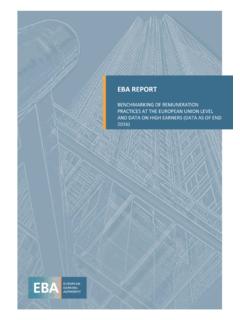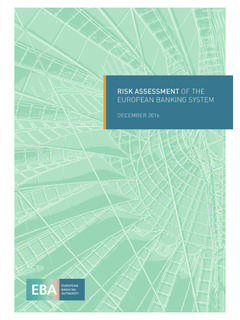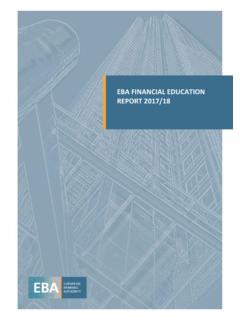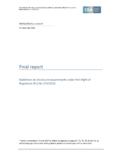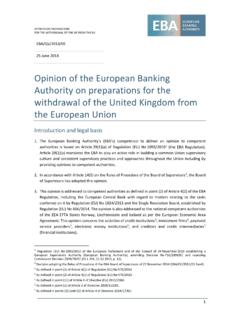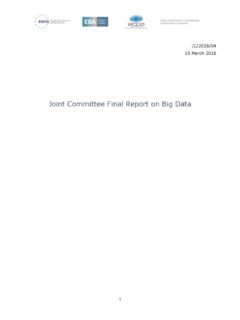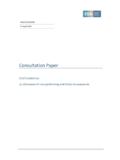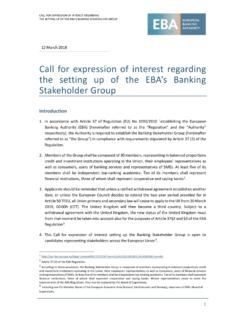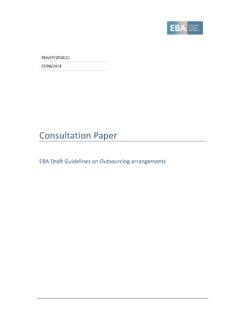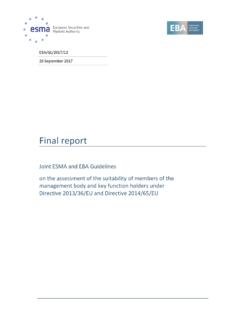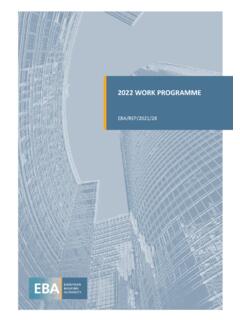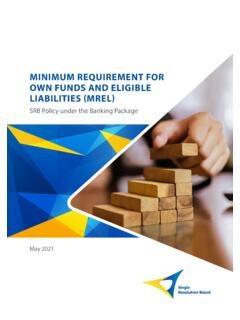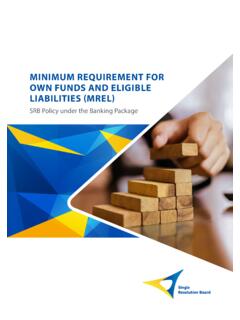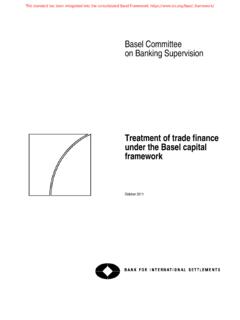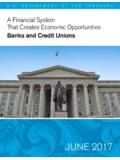Transcription of Consultation paper on revised SREP guidelines
1 GL ON COMMON PROCEDURES AND METHODOLOGIES FOR SREP AND SUPERVISORY STRESS TESTING EBA/CP/2021/26 28 June 2021 Consultation paper Draft guidelines on common procedures and methodologies for the supervisory review and evaluation process (SREP) and supervisory stress testing under Directive 2013/36/EU GL ON COMMON PROCEDURES AND METHODOLOGIES FOR SREP AND SUPERVISORY STRESS TESTING 2 Contents 1. Responding to this Consultation 6 Submission of responses 6 Publication of responses 6 Data protection 6 2. executive summary 7 Next steps 8 3. Background and rationale 9 4. Draft revised guidelines 16 Compliance and reporting obligations 18 Status of these guidelines 18 Reporting requirements 18 Title 1. Subject matter, definitions, level of application and implementation 19 Subject matter 19 Definitions 19 Level of application 23 Date of application 24 Repeal 24 Title 2.
2 The common SREP 25 Overview of the common SREP framework 25 Categorisation of institutions 25 Continuous assessment of risks 26 Periodic assessment of capital and liquidity adequacy 27 Overall SREP assessment 28 Dialogue with institutions, application of supervisory measures and communicating findings 28 Scoring in the SREP 29 Risk scores 30 Viability scores including an overall SREP score 30 Organisational arrangements 33 Proportionality and supervisory engagement 34 Category 1 institutions 35 Category 2 institutions 35 Category 3 institutions 36 Category 4 institutions 37 Minimum requirements for supervisory engagement 37 Title 3. Monitoring of key indicators 40 Title 4. Business model analysis 42 GL ON COMMON PROCEDURES AND METHODOLOGIES FOR SREP AND SUPERVISORY STRESS TESTING 3 General considerations 42 Preliminary assessment 44 Identifying the areas of focus for the BMA 45 Assessing the business environment 45 Analysis of the current business model 46 Quantitative analysis 46 Qualitative analysis 47 Analysis of the strategy and financial plans 47 Assessing business model viability 48 Assessing the sustainability of the institution s strategy 49 Identification of key vulnerabilities 50 summary of findings and scoring 50 Title 5.
3 Assessing internal governance and institution-wide controls 53 General considerations 53 Overall internal governance framework 54 Organisation and functioning of the management body 55 Corporate values and risk culture 56 Remuneration policies and practices 58 Internal control framework 59 Risk management framework 62 Risk appetite framework and strategy 62 ICAAP and ILAAP frameworks 63 Assessment of institutions stress testing 66 New products and significant changes 70 Information and communication technologies and business continuity management 71 Title 6. Assessing risks to capital 79 General considerations 79 Assessment of credit and counterparty risk 82 General considerations 82 Assessment of inherent credit risk 82 Assessment of credit risk management and controls 94 summary of findings and scoring 100 Assessment of market risk 102 General considerations 102 Assessment of inherent market risk 103 Assessment of market risk management and controls 107 summary of findings and scoring 113 Assessment of operational risk 114 General considerations 114 Assessment of inherent operational risk 116 Assessment of reputational risk 123 GL ON COMMON PROCEDURES AND METHODOLOGIES FOR SREP AND SUPERVISORY STRESS TESTING 4 Assessment of operational risk management.
4 Measurement and controls 125 summary of findings and scoring 131 Assessment of interest rate risk arising from non-trading book activities 133 General considerations 133 Assessment of inherent IRRBB 134 Assessment of IRRBB management and controls (both risk management and compliance, and internal audit control functions) 138 summary of findings and scoring 143 Title 7. SREP capital assessment 146 General considerations 146 Determining additional own funds requirements for risks other than the risk of excessive leverage 147 Determining additional own funds to cover unexpected losses 148 Determining own funds or other measures to cover model deficiencies 152 Determining own funds or other measures to cover other deficiencies 152 Determining the composition of additional own funds requirements 153 Additional own funds requirements for the risk of excessive leverage 153 Assessment of risk of excessive leverage 154 Reconciliation with any macroprudential requirements 158 Determining the TSCR, TSLRR.
5 OCR and OLRR 158 Articulation and justification of own funds requirements 160 Meeting requirements in stressed conditions 163 Using P2G to address the quantitative outcomes of stress testing 163 Capital planning and other supervisory measures to address capital adequacy in stressed conditions 169 summary of findings and scoring 171 Title 8. Assessing risks to liquidity and funding 177 General considerations 177 Assessing liquidity risk 179 Assessing inherent funding risk 183 Assessing liquidity and funding risk management 187 summary of findings and scoring 198 Title 9. SREP liquidity assessment 202 General considerations 202 Overall assessment of liquidity 202 Determining the need for specific liquidity requirements 204 Determination of specific quantitative liquidity requirements 204 Articulation of specific quantitative liquidity requirements 208 summary of findings and scoring 210 Title 10.
6 Overall SREP assessment and application of supervisory measures 214 GL ON COMMON PROCEDURES AND METHODOLOGIES FOR SREP AND SUPERVISORY STRESS TESTING 5 General considerations 214 Overall SREP assessment 215 Application of capital measures 218 Application of liquidity measures 219 Application of other supervisory measures 219 Supervisory reaction to a situation where TSCR or OCR is not met 229 Supervisory reaction to a situation where P2G is not met 230 Interaction between supervisory and early intervention measures 231 Interaction between supervisory and macro-prudential measures 231 Interaction between supervisory and AML/CFT measures 232 Title 11. Application of the SREP to cross-border groups 233 Application of the SREP to cross-border groups 233 SREP capital assessment and institution-specific prudential requirements 235 SREP liquidity assessment and institution-specific prudential requirements 237 Application of other supervisory measures 237 Title 12.
7 Supervisory stress testing 238 Use of supervisory stress testing by competent authorities 238 Key elements of supervisory stress testing 239 Organisational and governance arrangements within competent authorities 241 Process and methodological considerations 242 Annex 1. Operational risk, examples of the link between losses and risk drivers 246 Annex 2. Key features and differences between P2R and P2G 247 5. Accompanying documents 251 Draft cost-benefit analysis / impact assessment 251 Overview of questions for Consultation 264 GL ON COMMON PROCEDURES AND METHODOLOGIES FOR SREP AND SUPERVISORY STRESS TESTING 6 1. Responding to this Consultation The EBA invites comments solely on the amendments to the EBA guidelines on common procedures and methodologies for the supervisory review and evaluation process (SREP) and supervisory stress testing under Directive 2013/36/EU put forward in this paper and within the questions summarised in Comments are most helpful if they: respond to the question stated; indicate the specific point to which a comment relates; contain a clear rationale; provide evidence to support the views expressed/ rationale proposed; and describe any alternative regulatory choices the EBA should consider.
8 Submission of responses To submit your comments, click on the send your comments button on the Consultation page by 28 September 2021. Please note that comments submitted after this deadline, or submitted via other means may not be processed. Publication of responses Please clearly indicate in the Consultation form if you wish your comments to be disclosed or to be treated as confidential. A confidential response may be requested from us in accordance with the EBA s rules on public access to documents. We may consult you if we receive such a request. Any decision we make not to disclose the response is reviewable by the EBA s Board of Appeal and the European Ombudsman. Data protection The protection of individuals with regard to the processing of personal data by the EBA is based on Regulation (EU) 1725/2018 of the European Parliament and of the Council of 23 October 2018.
9 Further information on data protection can be found under the Legal notice section of the EBA website. GL ON COMMON PROCEDURES AND METHODOLOGIES FOR SREP AND SUPERVISORY STRESS TESTING 7 2. executive summary These guidelines , drawn up pursuant to Article 107(3) of Directive 2013/36/EU, are addressed to competent authorities and are intended to promote common procedures and methodologies for the supervisory review and evaluation process (SREP), which is an ongoing supervisory process bringing together findings from all supervisory activities into a comprehensive supervisory overview of an institution. These guidelines also aim at achieving convergence of practices followed by competent authorities in supervisory stress testing across the EU in accordance with Article 100 of Directive 2013/36/EU.
10 The review of SREP guidelines is carried out in order implement the changes brought by Directive (EU) 2019/878 amending Directive 2013/36/EU and Regulation (EU) 2019/876 amending Regulation (EU) No 575/2013. The main amendments include the following: the categorization of institutions and the application of the minimum engagement model were revised by reflecting the new definitions on small and non-complex and large institutions with a view to better reflecting the principle of proportionality; the assessment of the risk of money laundering and terrorist financing (ML/TF risks) was incorporated across the text, in line with the EBA Opinion on how to take into account ML/TF risks in the SREP published in November 20201; the provisions on Pillar 2 capital add-ons and the Pillar 2 guidance were reviewed in accordance with Articles 104a and 104b of Directive 2013/36/EU and to ensure that they reflect a purely microprudential perspective; in order to reflect the separate stack of own funds requirements based on the leverage ratio, clarifications were added on the related separate supervisory assessment of Pillar 2 capital add-ons and the Pillar 2 guidance to address the risk of excessive leverage ; the requirements for the assessment of the interest rate risk in the non-trading book, as well as the assessment of liquidity risk and liquidity adequacy were adjusted to align with the current regulatory framework .
